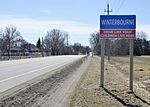West Montrose Covered Bridge, also known as the "Kissing Bridge", is a covered bridge in West Montrose, Ontario, within Waterloo Region, one of the oldest covered bridges in Canada. The bridge is the only remaining covered bridge in Ontario and the second oldest surviving bridge in the Region of Waterloo. (In 2015, the total number of surviving covered bridges in Canada was below 200.) John Bear, who had previously built barns, built the bridge in 1880–1881, mostly of oak and white pine. The total cost to the Township of Woolwich was $3,197.50. The structure can still be used by pedestrians, buggy traffic and vehicles weighing less than three tonnes for crossing the Grand River. Since 1998, it has been owned and maintained by the Regional Municipality of Waterloo.
The bridge's original design was described as a "two-span hybrid Howe truss" or as a "hybrid Queen Post – Howe timber configuration" with two louvred windows. (Additional windows, visible today, were added at some later date.) The entire structure was originally built of wood. Its weight was supported by 15 piles driven deep into the river bed. At the time of construction, the estimated useful life of the structure was 70 to 80 years. That was significantly increased with subsequent restorations.
The primary modifications during restorations added concrete and steel parts to strengthen the aging structure. However, the current visible form of the bridge remains true to the original design.








